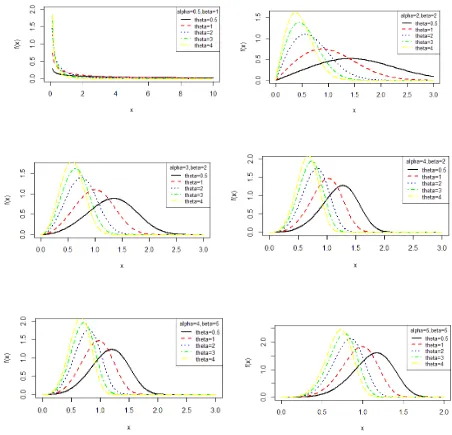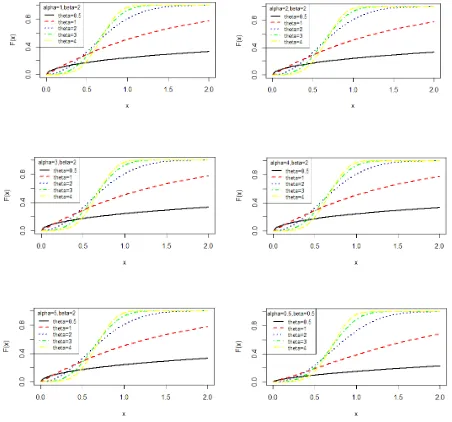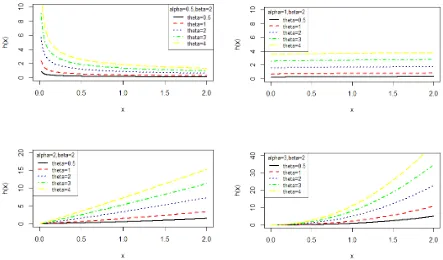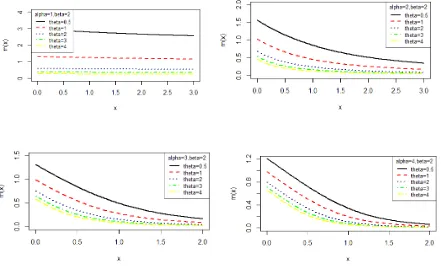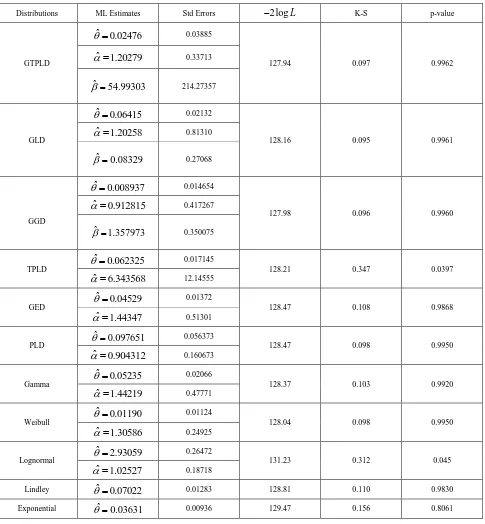A Generalization of Two-Parameter Lindley Distribution
with Properties and Applications
Rama Shanker1,*, Kamlesh Kumar Shukla1, Tekie Asehun Leonida2
1
Department of Statistics, Eritrea Institute of Technology, Asmara, Eritrea 2
Department of Applied Mathematics, University of Twente, The Netherlands
Abstract
In this paper, a generalization of two-parameter Lindley distribution (GTPLD), which includes one parameter exponential and Lindley distributions, two-parameter Lindley distribution (TPLD) of Shanker and Mishra (2013), Weibull distribution, gamma distribution, generalized gamma distribution of Stacy (1962) and power Lindley distribution of Ghitanyet al (2013) as particular cases, has been proposed. Its moments, hazard rate function, mean residual life function, order statistic, Renyi entropy measure has been studied. Method of maximum likelihood estimation has been discussed for estimating its parameters. Applications of the distribution have been explained with two examples of observed real lifetime datasets.
Keywords
Two-parameter Lindley distribution, Moments, Hazard rate function, Mean residual life function, Order statistic, Renyi entropy measure, Maximum likelihood estimation, Applications1. Introduction
Shanker and Mishra (2013) introduced a two-parameter Lindley distribution (TPLD) defined by its probability density function (pdf) and cumulative distribution function (cdf)
; ,
2
; 0, 0, 11
y
f y y e x
(1.1)
; ,
1 1 ; 0, 0, 11
y x
F y e x
(1.2) The pdf (1.1) can be expressed as
; ,
1
;
1
2 ; 2,
f y p g y p g y
where
1
p
,
1 ; ; 0, 0
y
g y e y
22 ; y ; 0, 0
g y y e y .
Clearly the density (1.1) is a two-component mixture of an exponential distribution with scale parameter and a gamma distribution with shape parameter 2 and scale parameter , with mixing proportion
1
p
. Shanker and Mishra (2013)
studied its various properties including coefficients of variation, skewness, kurtosis; hazard rate function, mean residual life
* Corresponding author:
shankerrama2009@gmail.com (Rama Shanker) Published online at http://journal.sapub.org/ijps
Copyright©2019The Author(s).PublishedbyScientific&AcademicPublishing
function and stochastic ordering. The estimation of its parameters using both the maximum likelihood estimation and the method of moments along with applications of TPLD to model lifetime data has also been discussed by Shanker and Mishra (2013). It can be easily shown that Lindley distribution, introduced by Lindley (1958), having pdf
;
2
1
; 0, 01
y
f y y e x
(1.3) is a particular case of TPLD (1.1) at 1. Lindley distribution has been studied in detail by Ghitany et al (2008). Shanker et
al (2015) have detailed and critical study on applications of exponential and Lindley distribution for modeling real lifetime data from biomedical sciences and engineering and observed that both exponential and Lindley are competing each other. Shanker et al (2016) have discussion on applications of gamma distribution and Weibull distribution for real lifetime data from engineering and biological sciences. Shanker (2016) has discussed various important statistical properties including coefficient of variation, skewness, kurtosis and index of dispersion along with various applications of generalized Lindley distribution (GLD) introduced by Zakerzadeh and Dolati (2009). Shanker and Shukla (2016) have detailed comparative study on applications of three-parameter generalized gamma distribution (GGD) and generalized Lindley distribution (GLD) and observed that these two distributions are competing each other for modeling lifetime data.
In this paper, an attempt has been made to derive a generalization of two-parameter Lindley distribution (GTPLD), which includes one parameter exponential and Lindley distributions, two-parameter Lindley distribution (TPLD) of Shanker and Mishra (2013), Weibull distribution, gamma distribution, generalized gamma distribution of Stacy (1962) and power Lindley distribution of Ghitany et al (2013) as particular cases. The moments, hazard rate function, mean residual life function, order statistic and Renyi entropy measure of the distribution have been studied. Method of maximum likelihood estimation has been discussed for estimating its parameters. Applications of the distribution have been explained with two examples of observed real lifetime datasets and its goodness of fit has been compared with other lifetime distributions.
2. A Generalization of Two-Parameter Lindley Distribution
Assuming the power transformation 1
X Y in (1.1), the pdf of Xcan be obtained as
2 1
1 ; , , ; 0, 0, 0, 1
1
x
f x x x e x
(2.1)
1 ; , 1 2 ; 2, ,
p g x p g x , (2.2) where,
1
p
,
11 ; , x ; 0, 0, 0
g x x e x
2 2 12 ; 2, , x ; 0, 0, 0
g x x e x .
Since at 1, (2.1) reduces to TPLD (1.1), we would call (2.1) a generalization of two-parameter Lindley distribution (GTPLD). Further, (2.1) is also a two-component mixture of Weibull distribution with shape parameter and scale parameter and a generalized gamma distribution with shape parameters
2,
and scale parameter , with mixingproportion
1
p
. At 1 and 1, (2.1) reduces to the Lindley distribution (1.3). At 1, (2.1) reduces to the
Power Lindley distribution introduced by Ghitany et al (2013) having pdf
2 1
2 ; , 1 ; 0, 0, 0
1
x
f x x x e x
(2.3) The gamma
2, distribution and a generalized gamma
2, ,
distribution are also particular cases of (2.1) for
0,1
and 0 respectively. It can be easily shown that (2.1) reduces to Weibull distribution for . Further, for 1 and , (2.1) reduces to exponential distribution.
1 ; , , 1 1 ; 0, 0, 0, 1
1
x
x
F x e x
(2.4)
We use X ~ GTPLD
, ,
to denote a random variable having GTPLD (2.1) with parameters , and having pdf (2.1) and cdf (2.4).The behavior of the pdf and the cdf of GTPLD have been shown graphically for varying values of parameters , and in figures 1 and 2 respectively.
Figure 2. Behavior of the cdf of GTPLD for varying values of parameters , and
3. Reliability Properties
3.1. Survival Function and Hazard Rate Function The survival function of GTPLD can be expressed as
; , ,
1
; , ,
1 ; 0, 0, 0, 11
x
x
S x F x e x
.
Thus the hazard rate function of GTPLD can be obtained as
2 1
; , ,
; , , ; 0, 0, 0, 1
; , , 1
x x
f x
h x x
S x x
.
Figure 3. Behavior of the hazard rate function of GTPLD for varying values of parameters , , and 3.2. Mean Residual Life Function
The mean residual life function, m x
; , ,
of GTPLD (2.1) can be obtained as
1
; , , ; , ,
; , ,
x
m x t f t dt x
S x
2
1
tx x
t t e dt x
x e
2
2 1
t
tx
x x
e t dt e t dt x
x e
.
Taking ut, which gives
1
t u and
1
1
dt u du
, we get
; , ,
2 1 1 1 1 2 11
u
ux
x x
m x e u du e u du x
x e
2
1 1
1 2
1 1
1, 2,
1
x
x x
x
x e
1
1 1
1, 2,
1
x
x x
x
x e
.
It can be easily verified that
12 1
1 1 0; , ,
1
m
. The behavior of m x
; , ,
of GTPLD for varying values of parameters , , and are shown in figure 4Figure 4. Behavior of the mean residual life function of GTPLD for varying values of parameters , , and
4. Statistical Properties
4.1. Moments
The rth moment about origin, r of GTPLD (2.1) can be obtained as
2
1
0
1
r r x
r E X x x e dx
2
1 2 1
0 0
1
x r x r
e x dx e x dx
.
Taking yx, which gives
1 x y and
1
1
dx y dy
1 1 2 1 1 2 0 0 1 1 1
r r y yr e y y dy e y y dy
2 1
2 1 1
0 0 1
r r y ye y dy e y dy
2 1 2 1 2
1
r r r r
2 ; 1, 2, 3,... 1 r r r r r (4.1.1)
Taking r1, 2,3 and 4 in (4.1.1), the first four moments about origin of GTPLD can be obtained as
1 2 1
1 1 1
2 2 2
2 2 2 1
3 2 3
3 3 3 1
3 2 4
4 4 4 1 .
The variance of GTPLD can thus be obtained as
2 2 2 22 2 1 2
2 4
2 1
2 2 1
1 .
The higher central moments, if required, can be obtained using the relationship between central moments and raw moments. The skewness and kurtosis measures, upon substituting for the raw moments, can be obtained using the expressions
Skewness
3
3 2 1
3
3 2
=
and Kurtosis
2 44 3 1 2 1 1
4
4 6 3
.
4.2. Distribution of Order Statistics
! 1
1
1 ! ! n k k Y n
f y F y F y f y
k n k
1
0
!
1 1 ! !
n kl k l l
n k n
F y f y
l
k n k
and
1
n j n jY
j k
n
F y F y F y
j
0 1
n n j l j lj k l
n n j
F y
j l ,
respectively, for k1, 2, 3,...,n.
Thus, the pdf and the cdf of kth order statistics of GTPLD are given by
1 2 1 0 ! 1 11 1 ! ! 1
k l x n kx Y
l
n x x e n k x
f y e
l
k n k
and
0
1 1 1
1
j l n j n l x Yj k l
n n j x
F y e
j l
4.3. Renyi Entropy Measure
An entropy of a random variable X is a measure of variation of uncertainty. A popular entropy measure is Renyi entropy
introduced by Renyi (1961). If X is a continuous random variable having probability density function f
. , then Renyi entropy is defined as
1
log 1
R
T f x dx
where 0 and 1.
Thus, the Renyi entropy for GTPLD (2.1) can obtained as
2
1
0 1 log 1 1
x RT x x e dx
2 1 0 1 log 1 1 1
x xx e dx
2 1 0 0 1 log 1 1
j x j xx e dx
j
2 0 0 1 1 log 1 1
j x j je x dx
j
Taking yx, which gives
1
x y and
1
1
dx y dy
, we get
1 2 0 0 1 1 log 1 1
y jR j
j
y
T e y dy
1
2 1
0 0
1 1
log
1 1
y jj j
e y dy
j
2 1
1
0
1
1 1
log
1 1
j
j
j j
.
5. Maximum Likelihood Estimation of Parameters
In this section the estimation of parameters of GTPLD using maximum likelihood estimation has been discussed. Assuming
x x x1, 2, 3,...,xn
a random sample from GTPLD
, ,
, the natural log-likelihood function,lnL of GTPLD can be expressed as
1 1 1
ln ln 2 ln ln 1 ln 1 ln
n i
n i
n ii i i
L n x x x .
The maximum likelihood estimates
ˆ, ,ˆ ˆ
of parameters
, ,
of GTPLD (2.1) is the solutions of the following natural log- likelihood equations1
ln 2
0 1
n i i
L n n
x
1 1 1
ln ln
ln ln 0
n n n
i i
i i i
i i i i
x x
L n
x x x
x
1
ln 1
0 1
n
i i
L n
x
These three natural log- likelihood equations do not seem to be solved directly because they cannot be expressed in closed forms. However, the MLE’s
ˆ, ,ˆ ˆ
of parameters
, ,
can be obtained directly by solving the log likelihood equation using Newton-Raphson iteration method available in R –Software till sufficiently close estimates of ˆ, ˆ and ˆ are obtained.6. Numerical Examples
The applications of GTPLD have been explained with two real lifetime datasets regarding failure times (in minutes) from Lawless (2003) pp. 204 and 263. The goodness of fit of GTPLD has been discussed along with the goodness of fit given by generalized Lindley distribution (GLD) introduced by Zakerzadeh and Dolati (2009), generalized gamma distribution introduced by Stacy (1962), two-parameter Lindley distribution of Shanker and Mishra (2013), generalized exponential distribution proposed by Gupta and Kundu (1999), power Lindley distribution introduced by Ghitany et al (2013), gamma distribution, Weibull distribution suggested by Weibull (1951), Lognormal distribution, Lindley distribution and exponential distribution. In table 1, the pdf and the cdf of fitted distributions has been presented. The goodness of fit of the fitted distribution has been presented in tables 2 and 3, respectively.
Dataset 1: The first set of datarepresents the failure times (in minutes) for a sample of 15 electronic components in an accelerated life test and the data are
1.4, 5.1, 6.3, 10.8, 12.1, 18.5, 19.7, 22.2, 23.0, 30.6, 37.3, 46.3, 53.9, 59.8, and 66.2. Dataset 2: The following data set represents the number of cycles to failure for 25 100-cm specimens of yarn, tested at a particular strain level, Lawless (2003) pp. 204 and 263.
Table 1. The pdf and the cdf of the fitted distributions
Distributions pdf and cdf
GLD
1 1
; , , ; 0, 0, 0, 0
1
x x
f x x e x
cdf
,
; , , 1 ; 0, 0, 0, 0
1
x
x x e
F x x
GGD
1; , , ; 0, 0, 0, 0
x
f x x e x
cdf
,; , , , 1 ; 0, 0, 0, 0
x
F x x
PLD
2
1
; , 1 ; 0, 0, 0
1
x
f x x x e x
cdf
; ,
1 1 ; 0, 0, 0 1
x
x
F x e x
GED
1
; , 1 x x; 0, 0, 0
f x e e x
cdf F x
; ,
1 ex
;x0, 0,0Weibull
pdf f x
; ,
x1ex ;x0,0, 0 cdf F x
; ,
1 ex ;x0,0, 0Gamma
1; , ; 0, 0, 0
x
f x e x x
cdf
,; , 1 ; 0, 0, 0
x
F x x
Lognormal
2 1 log 2
1
; , ; 0, 0, 0
2
x
f x e x
x
cdf
; ,
log ; 0, 0, 0
x
F x x
Table 2. ML estimates and summary of goodness of fit for dataset 1
Distributions ML Estimates Std Errors 2logL K-S p-value
GTPLD
ˆ 0.02476
0.03885
127.94 0.097 0.9962
ˆ 1.20279
0.33713
ˆ 54.99303
214.27357
GLD
ˆ 0.06415
0.02132
128.16 0.095 0.9961
ˆ 1.20258
0.81310
ˆ 0.08329
0.27068
GGD
ˆ 0.008937
0.014654
127.98 0.096 0.9960
ˆ 0.912815
0.417267
ˆ 1.357973
0.350075
TPLD
ˆ 0.062325
0.017145
128.21 0.347 0.0397
ˆ 6.343568
12.14555
GED ˆ 0.04529
0.01372
128.47 0.108 0.9868
ˆ 1.44347
0.51301
PLD ˆ 0.097651
0.056373
128.47 0.098 0.9950
ˆ 0.904312
0.160673
Gamma ˆ 0.05235
0.02066
128.37 0.103 0.9920
ˆ 1.44219
0.47771
Weibull ˆ 0.01190
0.01124
128.04 0.098 0.9950
ˆ 1.30586
0.24925
Lognormal
ˆ 2.93059
0.26472
131.23 0.312 0.045
ˆ 1.02527
0.18718
Table 3. ML estimates and summary of goodness of fit for dataset 2
Distributions ML Estimates Std Errors 2logL K-S p-value
GTPLD
ˆ 0.00853
0.00751
304.89 0.128 0.8031
ˆ 1.03725
0.14432
ˆ 19.02472
61.32714
GLD
ˆ 0.01018
0.00301
304.88 0.137 0.7370
ˆ 0.81866
0.48587
ˆ 3.97404
63.12878
GGD
ˆ 0.014831
0.022530
304.92 0.139 0.718
ˆ 1.989652
0.865396
ˆ 0.947350
0.213317
TPLD
ˆ 0.010927
0.001898
304.92 0.430 0.0001
ˆ 5.100397
21.23750
GED ˆ 1.88641
0.54466
304.98 0.178 0.2341
ˆ 0.00917
0.00176
PLD ˆ 0.014157
0.00190
304.93 0.137 0.728
ˆ 0.955741
0.00235
Gamma ˆ 0.01008
0.00294
304.87 0.138 0.721
ˆ 1.79528
0.45901
Weibull ˆ 0.00256
0.00068
306.57 0.931 0.0000
ˆ 1.14807
0.05897
Lognormal
ˆ 4.87956
0.17468
308.16 0.178 0.2300
ˆ 0.87433
0.12351
Lindley ˆ 0.01118 0.00156 305.01 0.129 0.7980 Exponential ˆ 0.00565 0.00109 309.18 0.202 0.2604
It is obvious from the goodness of fit of GTPLD that GTPLD is competing well with other lifetime distributions and hence can be considered an important lifetime distribution in statistics literature. The variance-covariance matrix of the estimated parameters of the GTPLD for datasets 1 and 2 has been given in tables 4 and 5, respectively.
Table 4. Variance-covariance matrix of GTPLD for dataset 1
ˆ ˆ ˆ
ˆ 0.00176 0.01337 5.19676 ˆ 0.01337 0.10684 36.88400 ˆ 5.19676 36.88400 18207.39274
Table 5. Variance-covariance matrix of GTPLD for dataset 2
ˆ ˆ ˆ
ˆ 0.000056 0.001058 0.380728 ˆ 0.001058 0.020828 6.632788 ˆ 0.380728 6.632788 3761.01813
7. Concluding Remarks
A generalization of two-parameter Lindley distribution (GTPLD), which includes one parameter exponential and Lindley distributions, two-parameter Lindley distribution (TPLD) of Shanker and Mishra (2013), Weibull distribution, gamma distribution, generalized gamma distribution of Stacy (1962) and power Lindley distribution of Ghitany et al (2013) as particular cases, has been proposed. Its raw moments, hazard rate function, mean residual life function, order statistic, Renyi entropy measure has been studied. Maximum likelihood estimation has been discussed for estimating its parameters. Applications of the distribution have been explained with two examples of observed real lifetime datasets from engineering and the goodness of fit is quite satisfactory over other one parameter, two-parameter and three-parameter lifetime distributions. .
ACKNOWLEDGEMENTS
Authors are grateful to the editor-in-chief and the anonymous reviewer whose comments improved the quality and the presentation of the paper.
REFERENCES
[1] Ghitany, M.E., Atieh, B. and Nadarajah, S. (2008): Lindley distribution and its Application, Mathematics Computing and Simulation, 78, 493 – 506.
[2] Ghitany, M.E., Al-Mutairi, D.K., Balakrishnan, N., and Al-Enezi, L.J. (2013): Power Lindley distribution and Associated Inference,
Computational Statistics and Data Analysis, 64, 20 – 33.
[3] Gupta, R.D. and Kundu, D. (1999): Generalized Exponential Distribution, Austalian & New Zealand Journal of Statistics, 41(2), 173 – 188.
[4] Lawless, J.F. (2003): Statistical Models and Methods for Lifetime Data, Wiley, New York.
[5] Lindley, D.V. (1958): Fiducial distributions and Bayes’ Theorem, Journal of the Royal Statistical Society, Series B, 20, 102 – 107. [6] Renyi, A. (1961): On measures of entropy and information, in proceedings of the 4th berkeley symposium on Mathematical Statistics
and Probability, 1, 547 – 561, Berkeley, university of California press.
[7] Shanker, R. and Mishra, A. (2013): A Two-Parameter Lindley Distribution, Statistics in Transition new Series, 14(1), 45-56. [8] Shanker, R., Hagos, F, and Sujatha, S. (2015): On modeling of Lifetimes data using exponential and Lindley distributions, Biometrics
& Biostatistics International Journal, 2(5), 1-9.
[9] Shanker, R. (2016): On generalized Lindley distribution and its applications to model lifetime data from biomedical science and engineering, Insights in Biomedicine, 1(2), 1 – 6.
[10] Shanker, R. and Shukla, K.K. (2016): On modeling of lifetime data using three-parameter Generalized Lindley and Generalized Gamma distributions, Biometrics & Biostatistics International Journal, 4(7), 1 – 7.
[11] Shanker, R., Shukla, K.K., Shanker, R. and Tekie, A.L. (2016): On modeling of Lifetime data using two-parameter Gamma and Weibull distributions, Biometrics & Biostatistics International journal, 4(5), 1 – 6.
